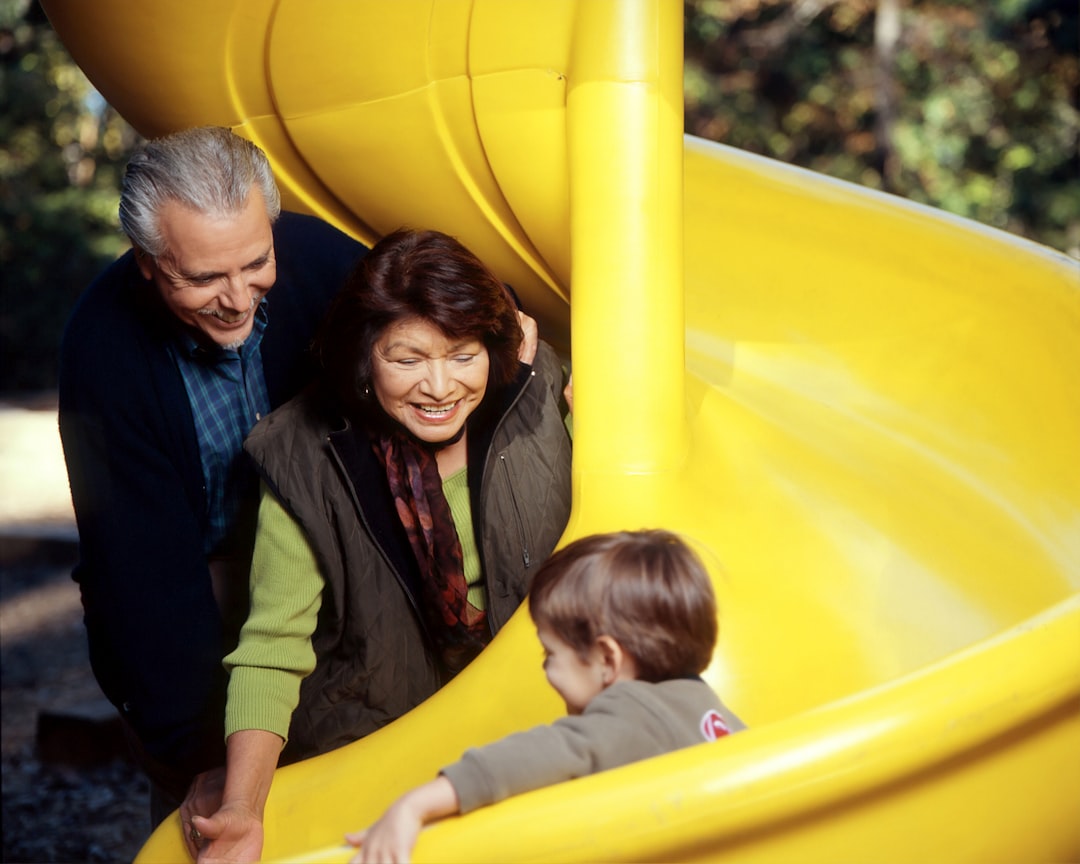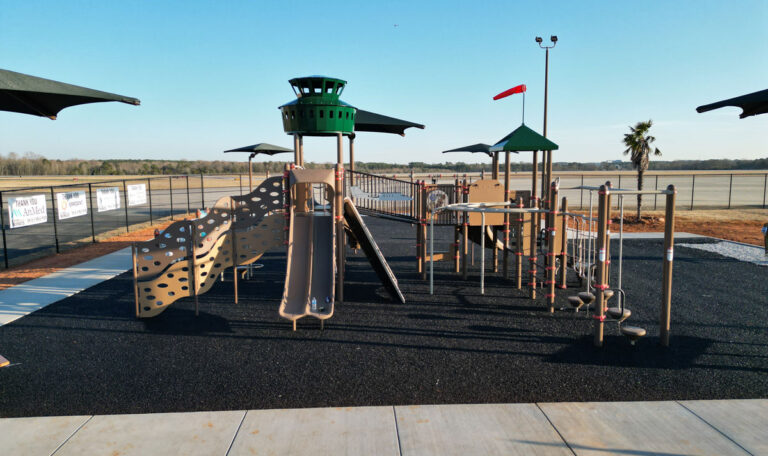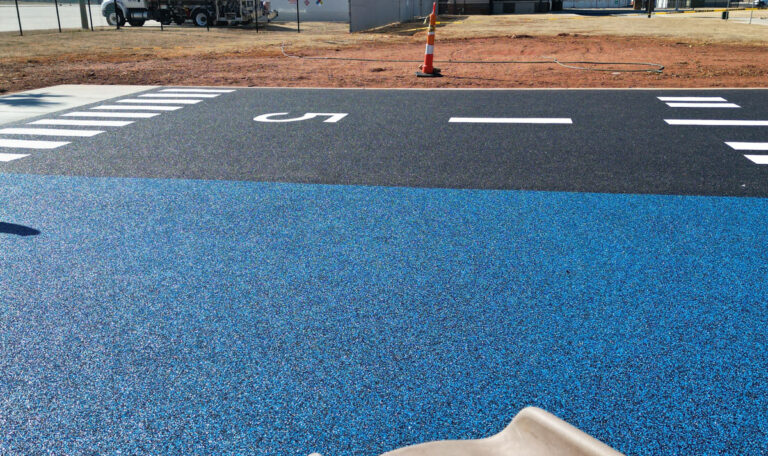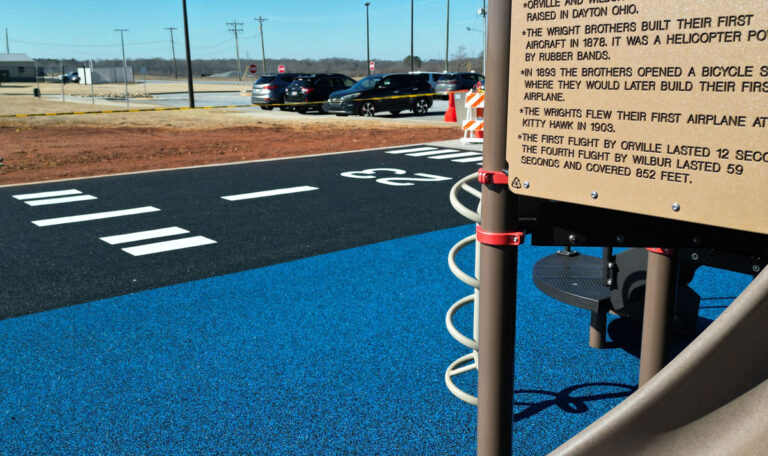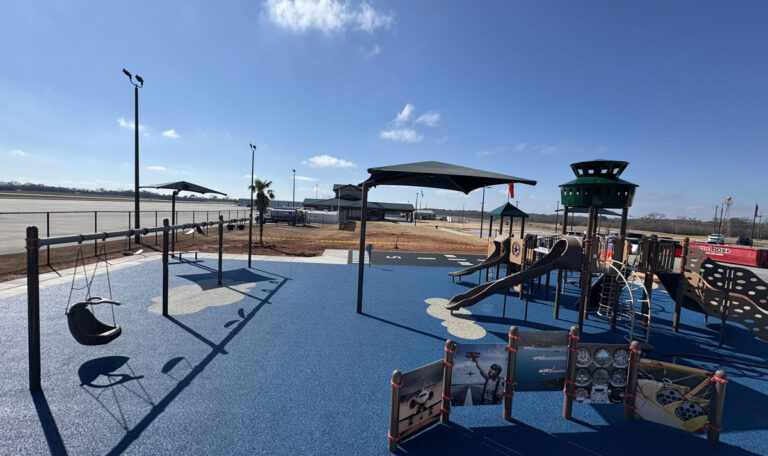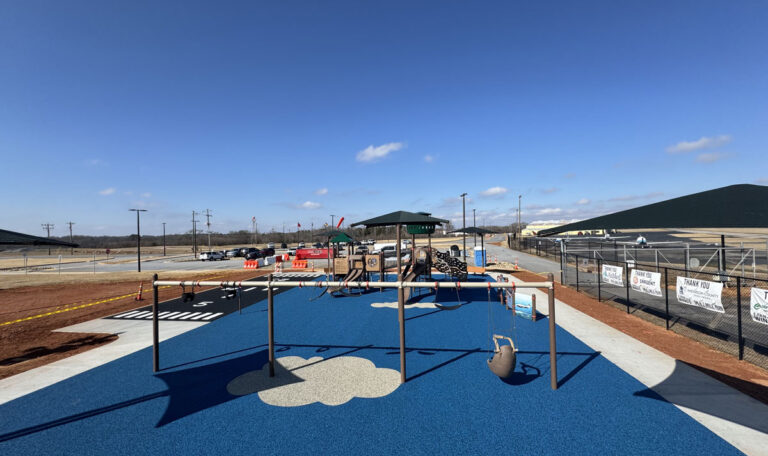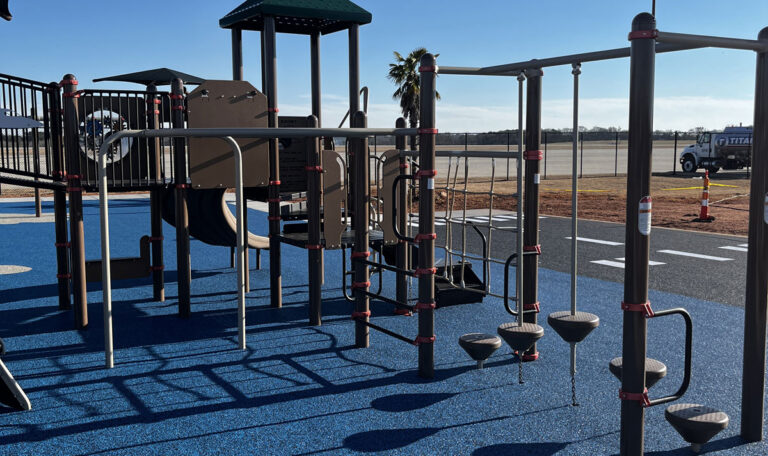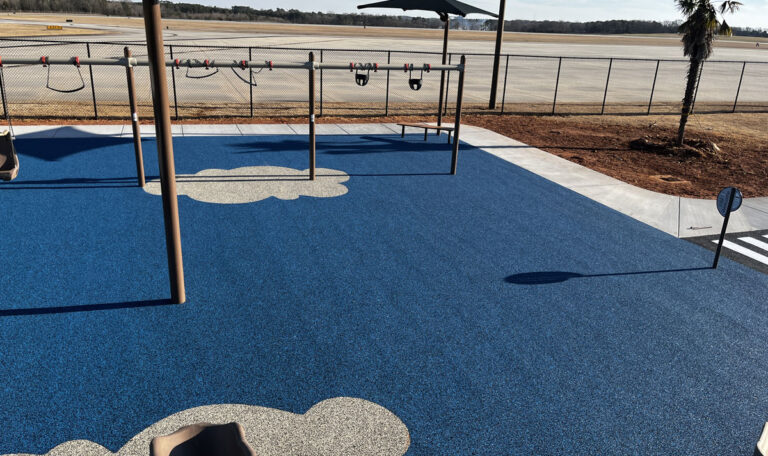Why Soft Fall Surfaces Are Critical for Playground Safety
Soft fall playground surfaces are specialized shock-absorbing materials designed to reduce injuries when children fall during play. They’re essential for playground safety and come in various forms including rubber tiles, poured-in-place rubber, engineered wood fiber, rubber mulch, sand, and cork.
Types of Soft Fall Playground Surfaces:
– Rubber Tiles: $5-8/sq ft, lasts 10-15 years, up to 10ft fall protection
– Poured Rubber: $7-15/sq ft, lasts 8-12 years, seamless installation
– Engineered Wood Fiber: $1-3/sq ft, requires regular topping up, up to 25ft fall protection
– Rubber Mulch: $4-6/sq ft, loose-fill option, minimal maintenance
– Cork Surfacing: Eco-friendly alternative, microplastic-free
The statistics are sobering: approximately 75% to 80% of all playground injuries are caused by falls. According to the Consumer Product Safety Commission (CPSC), around 500,000 injuries occur on playgrounds annually, with 44% resulting from falls to the ground. This is why choosing the right surfacing isn’t just about aesthetics or budget—it’s about preventing serious injuries.
When selecting a soft fall playground surface, you need to consider several factors:
- Critical fall height protection needs
- Budget constraints and long-term value
- Maintenance requirements and resources
- Accessibility for all users
- Environmental impact and sustainability
- Climate and drainage considerations
“The top three things to pay attention to at the playground are surfacing, surfacing, and surfacing,” notes one industry expert. This isn’t just clever wordplay—it reflects the reality that proper impact-attenuating surfaces are the single most important safety feature in any playground.
I’m Landon Olson, founder of Replay Surfacing, where we’ve transformed millions of pounds of scrap tires into safe, sustainable soft fall playground surfaces that meet rigorous safety standards while providing long-term value for our clients.

Important soft fall playground terms:
– installing rubber mulch
– non toxic playground tiles
– rubber mulch toxic
Inside a Soft Fall Playground: Why Impact Matters
When a child tumbles from playground equipment, what happens next depends almost entirely on what’s beneath them. The science behind soft fall playground surfaces isn’t just clever engineering—it’s about protecting our kids when gravity takes over.
Think about it: when a child falls, that energy has to go somewhere. On concrete, it transfers directly into their little bodies. But on a proper soft fall playground surface, the material absorbs and disperses that energy, dramatically reducing the force of impact.
Critical fall height is the playground safety gold standard—it’s the maximum height from which a person can fall without risking a life-threatening head injury. Every soft fall playground material has its own critical fall height rating, which should always match or exceed your tallest playground equipment.

Scientists measure playground safety using something called the Head Injury Criterion (HIC). It sounds technical, but it’s simply a way to gauge how likely a surface is to cause serious head trauma. Safety standards require HIC values below 1,000—the lower the number, the safer the landing.
This isn’t just theoretical safety talk. The Consumer Product Safety Commission has extensively researched playground falls, giving us clear data on how different materials at various depths protect children when they fall.
How does a soft fall playground reduce injuries?
Here’s a sobering fact: 75-80% of playground injuries happen because of falls. That’s why proper surfacing isn’t just a nice-to-have—it’s essential.
When a child falls onto a soft fall playground surface, three amazing things happen: First, the surface extends the deceleration time, reducing the peak force on impact (think landing on a pillow versus concrete). Second, it distributes that force across more of the body rather than concentrating it at one point. And third, it absorbs energy that would otherwise transfer directly to a child’s head and body.
This matters tremendously for preventing skull fractures and concussions, which can affect a child’s development long after the playground is a distant memory. The difference in outcomes is dramatic—a fall onto concrete from just 4 feet can be life-threatening, while the same tumble onto properly installed rubber surfacing typically results in nothing worse than a surprised expression.
That’s why at Replay Surfacing, we’re so passionate about creating shock-absorbing playground surfaces that exceed safety standards. We’ve seen how the right surface makes all the difference.
Typical lifespan of a soft fall playground surface
Quality soft fall playground surfacing is an investment in years of protection. Different materials offer different lifespans, which is important to consider when planning your playground:
Poured-in-place rubber typically lasts 8-12 years, while rubber tiles often make it to the 10-15 year mark. Rubber mulch provides 7-12 years of protection, engineered wood fiber needs regular top-ups but lasts 2-5 years between major replacements, and cork surfacing offers 5-8 years of natural protection.
UV stability is particularly important for durability—especially in sunny spots like our Tucson installations. Premium materials like our TPV surfaces maintain their bounce and bright colors even after years of sunshine and thousands of little feet.
Most quality surfaces include warranties ranging from 5-10 years, though with proper care, they often perform beautifully beyond that period. At Replay Surfacing, we stand confidently behind our products with comprehensive warranties—because we know from experience how durable recycled rubber surfacing can be when it’s done right.
After all, playground surfaces should last through years of laughter, countless games of tag, and all the wonderful energy that children bring to play spaces—while keeping them safe with every jump, tumble and landing.
Material Showdown: From Mulch to Rubber Tiles
Choosing the right soft fall playground surface feels a bit like selecting the perfect pair of shoes for your child—it needs to be the right fit, provide proper support, and ideally, look good too! Let’s walk through your options together, from economical natural materials to premium unitary surfaces.
When parents and facility managers ask me about surfacing choices, I often share this comparison to help them visualize the trade-offs:
| Material | Cost per sq ft | Fall Height Protection | Maintenance Level | Lifespan | Accessibility |
|---|---|---|---|---|---|
| Rubber Tiles | $5-8 | Up to 10ft | Low | 10-15 years | Excellent |
| Poured-in-Place | $7-15 | Up to 12ft | Low | 8-12 years | Excellent |
| Rubber Mulch | $4-6 | Up to 12ft | Medium | 7-12 years | Moderate |
| Engineered Wood Fiber | $1-3 | Up to 25ft | High | 2-5 years | Moderate |
| Sand | $1-2 | Up to 5ft | High | 1-3 years | Poor |
| Artificial Turf | $3-6 | Varies with infill | Medium | 8-10 years | Good |
| Cork Surfacing | $6-10 | Up to 8ft | Medium | 5-8 years | Good |
Beyond these practical considerations, the visual appeal matters too. While natural materials offer an earthy, subdued look, synthetic options like poured rubber and tiles can transform a playground into a vibrant canvas of colors and patterns—turning safety features into design elements!

Unitary Soft Fall Options
Think of unitary surfaces as the “one-piece wonders” of the playground world—seamless, consistent, and ready for action day after day with minimal fuss.
Poured-in-Place Rubber creates a playground surface that feels almost like a work of art. We start with a foundation layer of recycled SBR rubber (yes, those are actually recycled tires finding new life!) and top it with colorful EPDM or TPV granules. The result? A custom-fitted surface that can include everything from hopscotch patterns to school mascots.
I’ve seen the joy on children’s faces when they find a new playground with our poured-in-place rubber, especially in busy community parks like those we’ve installed in Nashville and Raleigh. Parents appreciate the wheelchair accessibility, while maintenance staff love that there’s no mulch to rake or tiles to adjust.
Rubber Tiles are the practical problem-solvers of the soft fall playground world. These pre-made puzzle pieces offer consistent protection with the advantage of easy replacement if damage occurs. One school administrator in Beaverton told me, “We replaced just two tiles after five years—try doing that with any other surface!”
Our EPDM rubber playground tiles maintain their vibrant colors even after years in the sun, which explains their popularity in sunny climates. They’re also a favorite for DIY-minded organizations working with limited installation windows.
Loose-Fill Classics & Naturals
There’s something wonderfully nostalgic about natural playground surfaces—the familiar crunch underfoot and the earthy scent that takes many of us back to our own childhood playgrounds.
Engineered Wood Fiber (EWF) might look like simple wood chips, but don’t be fooled—this specially processed material creates a surprisingly sophisticated safety surface. The fibers interlock (or “knit” together) to form a stable surface that can protect falls from heights up to 25 feet when properly installed and maintained.
The natural appearance of EWF makes it blend beautifully with park settings, though it does require regular depth checks and occasional top-ups. One park director mentioned to me, “Our maintenance team rakes it weekly, but the natural look and feel are worth the extra effort.”
Sand and Certified Bark continue to have their devoted fans, particularly for nature-themed play areas and budget-conscious projects. While they offer the lowest initial investment, they do come with higher long-term maintenance needs and accessibility challenges. These materials can be perfect for certain settings, particularly natural playgrounds or areas where children engage in creative, loose-parts play.
Cork Granules offer an interesting middle path—natural material with performance that rivals some synthetics. Made from the bark of cork oak trees (which regrows after harvesting), this material brings sustainability credentials that many communities now prioritize.
Emerging Green Alternatives
The playground industry is experiencing a green revolution, with new soft fall playground options emerging that keep both children and the planet safe.
Cork Surfacing has gained traction among environmentally conscious communities seeking microplastic-free alternatives. Unlike many synthetic options, cork is biodegradable at the end of its useful life while still providing reliable fall protection during its 5-8 year lifespan.
Nike Grind Blends represent innovative thinking about waste streams—turning worn-out athletic shoes into colorful, durable playground surfaces. This approach resonates with communities looking to teach children about recycling and sustainability through everyday examples.
At Replay Surfacing, we’re particularly proud of our circular economy approach. Each playground we install in places like Columbia, SC and Lake Charles, LA represents thousands of tires diverted from landfills. One school principal in Louisiana told me, “The kids were amazed to learn their playground used to be tires—it sparked a whole unit on recycling!”
By changing potential environmental hazards into safe places for children to play, we’re creating a legacy of both environmental and community health—one playground at a time.
Safety, Accessibility & Compliance Checklist
Creating a safe soft fall playground isn’t just about choosing nice materials—it’s about meeting specific safety standards that protect children from serious injuries. These standards vary depending on where you live, but they all share the same goal: keeping kids safe while they play.
In the United States, playground designers and owners need to follow these key standards:
- ASTM F1292: This is the gold standard for impact attenuation—basically, how well your surface absorbs shock when a child falls.
- ASTM F1951: This standard ensures surfaces are accessible for everyone, including those using mobility devices.
- ADA (Americans with Disabilities Act): These requirements ensure children of all abilities can access and enjoy playground equipment.
If you’re outside the US, you’ll need to follow standards like EN1177 in Europe or AS/NZ 4422 in Australia and New Zealand. While there are some differences between these international guidelines, they all focus on the same thing—protecting little heads from serious injuries during falls.
Not sure if your playground meets these standards? A Certified Playground Safety Inspector (CPSI) can help. At Replay Surfacing, our team includes CPSI-certified experts who guide clients through compliance requirements whether they’re in Sanford, NC or anywhere else we serve.
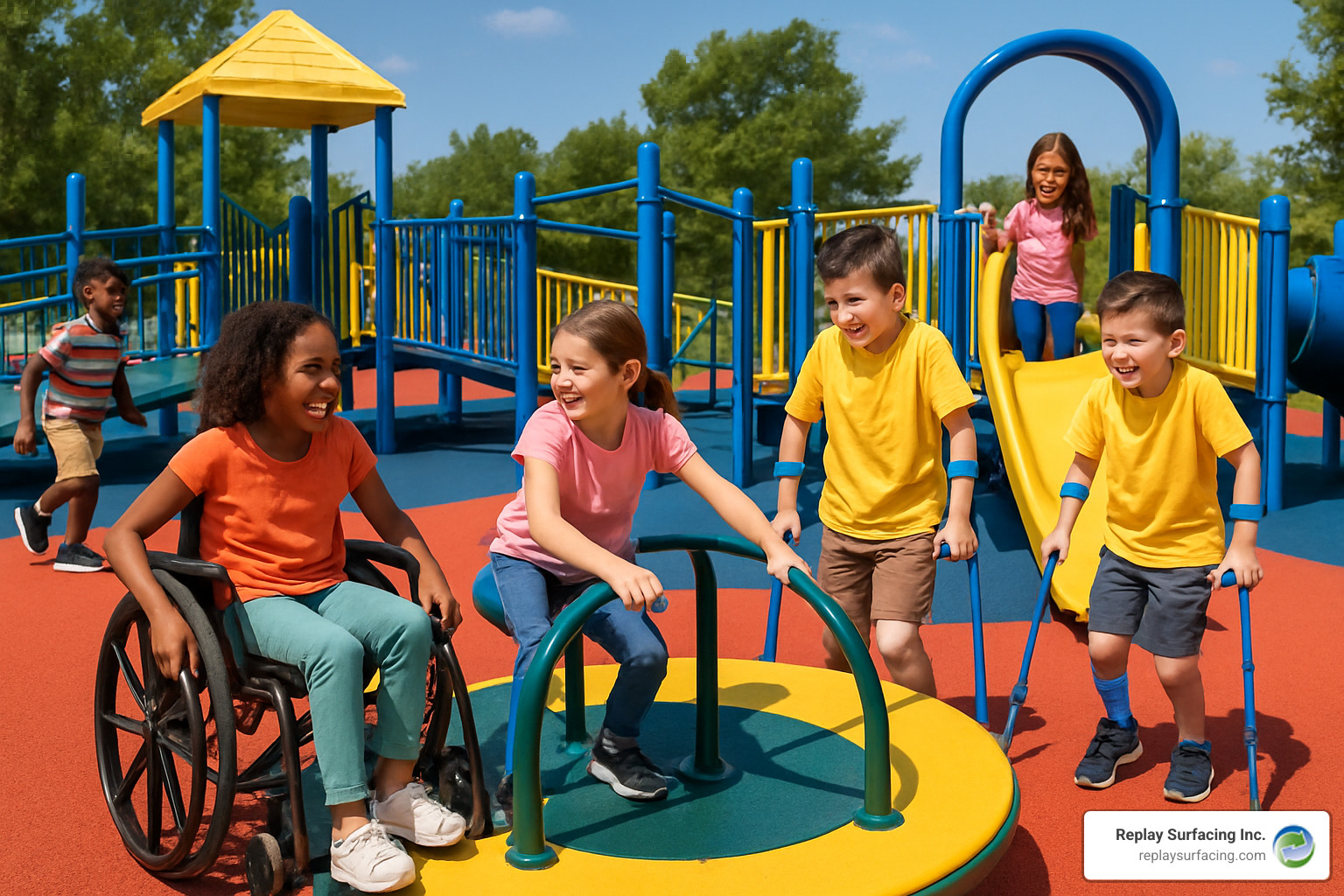
Meeting Fall-Height & HIC Requirements
The Head Injury Criterion (HIC) might sound complicated, but it’s simply a scientific way to measure how likely a surface is to cause head injuries during a fall. These measurements form the backbone of playground safety standards worldwide.
To meet these crucial requirements, you’ll need to consider several factors:
First, you need to match your surface to your equipment height. Every piece of playground equipment has what’s called a “critical fall height”—the highest point from which a child might tumble. Your soft fall playground surface must provide adequate protection for this specific height.
For loose-fill materials like engineered wood fiber or rubber mulch, depth matters tremendously. Generally, 9 inches of material will protect falls from about 7 feet, while 12 inches can handle falls from around 12 feet. These depth requirements are non-negotiable for safety.
Surfaces change over time. They compact, degrade, and wear down, potentially reducing their protective qualities. Regular playground audits ensure your surface continues to meet safety standards years after installation. At Replay Surfacing, we recommend scheduling these checks at least annually.
Keeping good records might not seem exciting, but documenting your installation, testing, and maintenance creates an important safety record. These documents demonstrate your commitment to playground safety and can be invaluable if questions ever arise.
Designing an Inclusive Soft Fall Playground
True playground safety means ensuring all children can play safely, regardless of ability. The ADA requires accessible routes to and throughout play areas, but creating a truly inclusive playground goes beyond just meeting minimum requirements.
For soft fall playground surfaces, inclusivity starts with wheelchair accessibility. You need firm, stable surfaces that allow wheelchair navigation without excessive effort. This is where unitary surfaces like our poured-in-place rubber and certain tile systems truly shine—they provide consistent, smooth pathways that work for everyone.
Thoughtful design also incorporates sensory zones with different textures and colors. These provide valuable sensory feedback for children with visual impairments and make the playground more engaging for everyone. The best playgrounds offer a rich mix of sensory experiences through varying surface textures and colors.
Color contrast does more than make a playground look nice—it serves as a critical safety feature. Using distinct colors to mark changes in elevation or different play zones helps children with visual impairments steer safely. Bold color boundaries can signal transitions between active play areas and quieter spaces.
Tactile cues—changes in surface texture—provide important navigational information for children with visual impairments. These subtle design elements help all children understand the playground layout intuitively.
At Replay Surfacing, our EPDM rubber playground installations offer endless possibilities for incorporating multiple colors and designs. These aren’t just decorative—they create visually appealing spaces while improving safety and accessibility through thoughtful color contrast and zone definition.
By carefully considering these safety and accessibility requirements, you’re not just checking boxes—you’re creating a soft fall playground where all children can play safely and confidently.
Budget, Installation & Upkeep
Let’s talk money—because creating a soft fall playground involves more than just the initial price tag. While you might start by comparing material costs, the true investment includes installation, ongoing maintenance, and eventual replacement.
Most playground surfacing falls within $3-$8 per square foot, but this range widens considerably depending on your material choice. Loose-fill options like engineered wood fiber might start around $1 per square foot, while premium poured-in-place rubber surfaces can reach $15 per square foot in complex installations.
Don’t let sticker shock drive your decision, though. Those pricier unitary surfaces often deliver better long-term value through reduced maintenance costs and extended lifespans. As one of our Memphis clients put it, “We spent more upfront on poured rubber, but five years later, we haven’t spent a dime on maintenance while our neighboring park has replaced their wood chips twice.”

Site preparation is the unsung hero of playground surfacing. Proper drainage prevents water pooling that can degrade materials and create slip hazards. A well-prepared subbase ensures your surface maintains its protective qualities for years. While these elements add to your initial costs, they’re far less expensive than premature replacement due to poor drainage or subbase failure.
Installation Pathways
Not all soft fall playground surfaces require professional installation, though expertise always adds value.
If your maintenance team or community volunteers have basic skills, interlocking rubber tiles can be a DIY-friendly option. With proper tools and instructions, these systems create safe surfaces without specialized equipment. One school principal in Raleigh told us, “Our PTA installed the tiles over a weekend. They followed Replay’s guidance, and the result has been fantastic.”
For loose-fill materials like rubber mulch or engineered wood fiber, installation is straightforward but requires attention to proper depth and containment. Many of our clients handle the spreading themselves after we deliver the materials.
Poured-in-place rubber, however, is definitely not a DIY project. These systems require specialized mixing equipment, experienced crews, and precise timing. Weather conditions significantly impact installation—temperatures below 50°F or above 90°F can affect curing, as can humidity and precipitation. Our installation teams carefully monitor forecasts to ensure ideal conditions for our Charlotte, Beaverton, and other installations nationwide.
A typical professional installation takes 3-5 days, though larger or more complex designs may require more time. We always work with clients to minimize disruption, often scheduling installations during school breaks or lower-use periods.
Maintenance & When to Replace
Even the most durable soft fall playground surfaces need regular attention to maintain their protective qualities. Think of it like maintaining a car—regular check-ups prevent costly breakdowns.
Seasonal inspections should become routine. For loose-fill materials, regular depth checks are crucial—areas under swings and at slide exits compact quickly. Our simple “knuckle test” helps clients verify adequate depth: push your fist into the material with your thumb extended upward. If the material doesn’t reach your thumb’s base, it needs additional material.
For unitary surfaces like poured rubber or tiles, watch for early signs of wear. Small cracks can often be repaired before they expand, saving significant replacement costs. Areas showing fading may indicate UV degradation that could affect performance. And any spot that feels significantly harder than surrounding areas may have lost its shock absorption.
Cleaning methods vary by material. Most unitary surfaces can be cleaned with a leaf blower, gentle pressure washing, or even a garden hose. Loose-fill materials benefit from regular raking to prevent compaction and remove debris.
Know when it’s time for replacement. Key indicators include:
– Visible base layer showing through the surface
– Widespread hardening or loss of bounce
– Extensive cracking or separation
– Persistent drainage problems
– Areas failing the “knuckle test” despite adding material
For a deeper dive into the economics of playground surfacing, our guide on understanding rubber playground surfacing costs helps clients plan for the entire lifecycle of their surface.
At Replay Surfacing, we believe in honest conversations about maintenance. While we’re proud of our durable products, we’d rather help you maintain your surface properly than sell you a premature replacement. That’s why we provide detailed care instructions with every installation and remain available for consultation years after the initial project.
Choosing & Future-Proofing Your Surface
Selecting the perfect soft fall playground surface isn’t just about what works today—it’s about what will continue protecting children for years to come. Think of it as choosing a partner rather than a product; you need something reliable that grows with you through all seasons.
When I work with clients across the country, from the scorching heat of Tucson to the ever-changing weather in Connecticut, I always start with these six essential considerations:
First, conduct an honest risk assessment. Those towering play structures that kids love require surfaces with greater fall protection—there’s simply no way around this safety fundamental.
Your local climate plays a huge role too. The relentless Arizona sun affects materials differently than the freeze-thaw cycles in northern states. I’ve seen perfectly good surfaces fail prematurely simply because they weren’t matched to their environment.
Then there’s the budget matrix—perhaps the trickiest balancing act. The initial price tag is just the beginning of the story. A cheaper upfront option often demands more maintenance and earlier replacement, while premium surfaces might actually cost less over their lifetime.
Don’t overlook aesthetics! Your playground should inspire joy and creativity. The right colors and designs don’t just look pretty—they can define play zones, improve accessibility, and integrate beautifully with your surroundings.
Sustainability matters more than ever. At Replay Surfacing, we’re passionate about our environmental impact, changing potential waste into safe play spaces. Parents and communities increasingly value this commitment to our planet’s future.
Finally, keep an eye on innovations in the industry. New materials and technologies emerge regularly, offering improved performance, sustainability, and value.
Quick-Start Decision Framework
Making this important decision doesn’t have to be overwhelming. I’ve helped hundreds of clients through this process with a straightforward approach:
Start with a thorough site survey. Understanding your drainage patterns, sun exposure, and existing conditions provides the foundation for every other decision. I remember a school in Nashville that skipped this step and ended up with pooling water after every rain—a problem that could have been easily avoided.
Next, determine your critical fall height requirements based on your tallest equipment. This isn’t negotiable—safety standards exist for a reason.
Consider who’ll be using your playground. A preschool has very different needs than a community park serving children of all ages and abilities. The surfaces that work best for toddlers might not be ideal for more adventurous older kids.
Be realistic about your maintenance capacity. I’ve seen beautiful playgrounds deteriorate because the maintenance team simply didn’t have the time or resources to keep up with demanding surfaces. If you have limited maintenance staff, investing in a lower-maintenance option makes sense.
Finally, think about the total lifecycle budget. A soft fall playground surface is a long-term investment in children’s safety. Looking beyond the initial price tag to consider the total cost of ownership over 10-15 years often leads to smarter decisions.
Frequently Asked Questions about Soft Fall Surfacing
Which soft fall material offers the best balance of cost and safety?
This is probably the question I hear most often, and the answer isn’t one-size-fits-all. For many budget-conscious schools and parks, engineered wood fiber (EWF) hits the sweet spot at just $1-3 per square foot while providing excellent fall protection—up to an impressive 25 feet when properly installed.
However, when we factor in the ongoing maintenance costs, rubber mulch often emerges as the better long-term value. While it costs more upfront ($4-6 per square foot), its minimal maintenance requirements and 7-12 year lifespan make the numbers work out favorably over time.
For clients who prioritize accessibility and truly minimal maintenance, poured-in-place rubber or tiles typically provide the best long-term value. Yes, they cost more initially, but their durability and performance often justify the investment.
How thick should soft fall be under a 3 m platform?
Safety standards are clear about this, though the answer varies by material. For a platform approximately 10 feet (3 meters) high:
Poured-in-place rubber needs to be 3.5-4 inches thick, as does a rubber tile system. Rubber mulch requires a 6-inch depth, while engineered wood fiber should be at least 9 inches deep. If you’re using sand (though I don’t typically recommend it), you’d need a full 12 inches.
These are minimum requirements—I always recommend erring on the side of caution. At Replay Surfacing, we provide detailed specifications based on your specific equipment and safety needs.
Can I install soft fall playground surfacing myself?
The DIY approach works well for certain soft fall playground materials. Interlocking rubber tiles, rubber mulch, and engineered wood fiber can all be installed by a determined team with basic tools like measuring tape, a level, rubber mallet, utility knife, and landscape rake.
However, proper preparation is critical. The subbase needs to be level and well-drained, and consistent depth is essential for loose-fill materials. I’ve seen well-intentioned DIY projects fail because these fundamentals were overlooked.
For most clients, professional installation provides peace of mind and often comes with valuable warranties. Our installation teams at Replay Surfacing bring specialized equipment and expertise to projects from Columbia, SC to Raleigh, NC, ensuring your surface meets all safety standards from day one.
While DIY can save money upfront, professional installation often proves its value over time through proper compliance with safety standards and superior performance. Plus, there’s something to be said for the confidence of knowing experts handled such an important safety feature.
Conclusion
Creating a safe, accessible, and sustainable soft fall playground is truly both an art and a science. I’ve seen how the right surface can transform a playground from a potential hazard zone into a vibrant, safe space where children thrive.
At Replay Surfacing, we’re doing something that makes us incredibly proud – tackling two important challenges simultaneously. We’re helping keep kids safe during those exuberant moments of play while also giving discarded tires a meaningful second life. There’s something deeply satisfying about watching children laugh and play on surfaces made from materials that would otherwise sit in landfills for centuries.
The beauty of eco-friendly rubber and recycled tire products is their remarkable durability coupled with their shock-absorbing properties. When you invest in quality soft fall playground surfacing, you’re not just checking a safety box – you’re making a decision that pays off through fewer injuries, reduced maintenance headaches, and a much longer time between replacements.
I remember visiting a school in Nashville that had installed our poured-in-place surface five years earlier. The principal told me they hadn’t had a single serious fall injury since installation, compared to multiple incidents each year with their previous surface. Stories like these remind us why this work matters.
The playground surfacing world continues to evolve in exciting ways. We’re seeing promising innovations with cork blends and specialized recycled composites that push safety standards even higher while reducing environmental footprints even further. At Replay Surfacing, we’re committed to staying at the cutting edge of these developments, bringing the best options to communities from Tucson to Connecticut.
The long-term value of quality surfacing simply can’t be overstated. When you consider the reduced risk of injuries, lower maintenance requirements, and extended replacement intervals, the initial investment makes perfect sense – especially when you factor in the peace of mind that comes from knowing you’ve created a truly safe play environment.
I invite you to explore our complete range of playground solutions and reach out to our team. We’d love to help you create a safer, more sustainable play space for your community.
When it comes to playground safety, what goes under the equipment truly is just as important as the equipment itself. Make your soft fall playground surface a priority—because every child deserves a safe place to play, and our planet deserves solutions that give materials a second chance.

